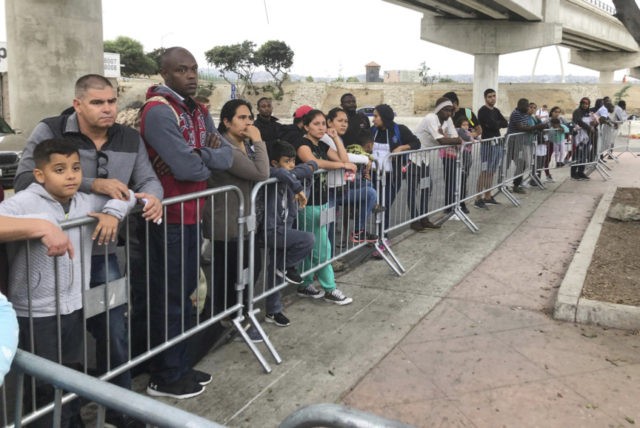Most Americans want sharp reductions to the annual inflow of roughly one million legal immigrant workers, consumers, and renters.
Rasmussen asked 1,250 likely voters in mid-December: “Which is closest to the number of new immigrants the government should be adding each year — fewer than 500,000, 750,000, one million, one and a half million, or more than one and a half million?”
Fifty-one percent said they want immigration sharply reduced, including 36 percent who said they want fewer than 500,000 immigrants and 15 percent who said they want fewer than 750,000 new migrants.
In contrast, just 17 percent said they want legal immigration raised to at least 1.5 million a year.
Those 51 to 17 percent result shows three Americans want immigration reductions for every one American who wants migration increases.
The poll also showed that 17 percent of respondents said they want to keep the current inflow of one million per year, and 15 percent said they were “not sure.”
Americans without college degrees were more eager for major reforms than college-trained Americans. For example, 58 percent of non-college voters want reductions compared to 46 percent of college graduate Americans.
Racial differences were modest. Hispanics voters split 51 percent for reductions, 22 percent for increases, and 13 percent “not sure.” Black likely voters split 48 percent for cuts, 15 percent for increases, and 20 percent for “not sure.”
Whites split 52 percent for reductions, 16 percent for increases, and 15 percent “not sure.
Democrats split 42 percent for reductions and 23 percent for increases. But liberals were the most pro-migration group, with just 28 percent for cuts and 32 percent for increases.
Class differences were strong. Respondents who earn more than $100,000 a year split 41 percent for reductions, 24 percent for increases.
Business groups and investors want the federal government to stimulate economic growth and stock values by adding more immigrant workers and more consumers. Faster population growth means higher forecasts for economic consumption, sales, housing prices, and profits, thus boosting the value of stock prices on Wall Street.
In contrast, wage-earning Americans gain from a reduced migrant inflow. Any declines in worker population pressure employers to compete for new employees by offering higher wages and by training sidelined Americans. The slower population growth also allows young Americans to migrate to good jobs in other regions, and to buy homes in good locations at lower costs. Slower population growth also forces employers to buy labor-saving machines to allow employees to earn more by getting more work done each day.
Those changes also mean that slower population growth — via lower births or reduced immigration — also tends to transfer wealth from older investors back to young wage-earners.
In 2018, President Donald Trump pushed for major cuts to immigration but was blocked by GOP and Democratic legislators. In 2020, he is likely to push a reform plan that would not change the overall level of migration.
The Rasmussen pollsters did not tell respondents about the current immigration rate — or the comparable number of Americans who are born each year. For example, 3.7 million Americans were born in the 12 months up to mid-2019, including many children born to non-immigrant foreigners, including illegals, visa workers and pregnant tourists who trying to steal citizenship for their children.
But the total legal and illegal immigration numbers likely were far above one million. So the border reports and census data suggest that Congress allowed the immigration of almost one foreigner for every two Americans who were born in 2019.
Also, the same Rasmussen poll showed much stronger public opposition to many employers’ use of migrants to push Americans out of well-paid jobs.
A Rasmussen survey shows likely voters by 2:1 want Congress to make companies hire & train US grads & workers instead of importing more foreign workers.
The survey also shows this $/class-based view co-exists w/ much sympathy for illegal migrants. #S386https://t.co/OSLHdG7Sni— Neil Munro (@NeilMunroDC) December 30, 2019
The survey asked voters:
When businesses say they are having trouble finding Americans to take jobs in construction, manufacturing, hospitality and other service work, what is generally best for the country? Is it better for businesses to raise the pay and try harder to recruit [Americans]?
Sixty percent of likely voters agreed it is “better for businesses to raise the pay and try harder to recruit non-working Americans even if it causes prices to rise.”
Just 22 percent of Americans, including 28 percent of liberals and 16 percent of conservatives, say it is “better for the government to bring in new foreign workers to help keep business costs and prices down.” Seventeen percent said they were “not sure.”
Read the survey here.
NYT admits ICE deportations boost wages for Americans.
But it downplays those blue-collar gains to help shield the elites' self-serving preference for migration and diversity.https://t.co/HvhAk5bZ1S— Neil Munro (@NeilMunroDC) December 29, 2019

COMMENTS
Please let us know if you're having issues with commenting.